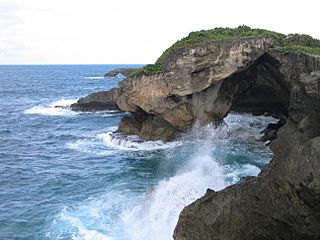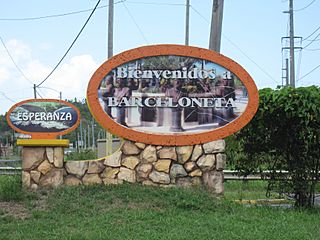Barceloneta, Puerto Rico facts for kids
Quick facts for kids
Barceloneta
Municipio Autónomo de Barceloneta
|
|||
|---|---|---|---|
|
Town and Municipality
|
|||

Barceloneta in letters sculpture
|
|||
|
|||
| Nicknames:
"La Ciudad de las Piñas", "La Ciudad Industrial," "El Pueblo de los Indios", "El Pueblo de Sixto Escobar"
|
|||
| Anthem: "Querido Barceloneta" | |||

Map of Puerto Rico highlighting Barceloneta Municipality
|
|||
| Sovereign state | |||
| Commonwealth | |||
| Settled | early 19th century | ||
| Founded | July 1, 1881 | ||
| Founded by | Bonocio Llenza Feliú | ||
| Named for | Barcelona | ||
| Barrios | |||
| Area | |||
| • Total | 36.39 sq mi (94.24 km2) | ||
| • Land | 32 sq mi (82 km2) | ||
| • Water | 4.73 sq mi (12.24 km2) | ||
| Population
(2020)
|
|||
| • Total | 22,657 | ||
| • Rank | 56th in Puerto Rico | ||
| • Density | 622.68/sq mi (240.418/km2) | ||
| Demonym(s) | Barcelonetences | ||
| Time zone | UTC−4 (AST) | ||
| ZIP Code |
00617
|
||
| Area code(s) | 787/939 | ||
| Major routes | |||
Barceloneta (Spanish pronunciation: [baɾseloˈneta], locally [baɭseloˈneta]) is a town and municipality in Puerto Rico located in the north region, bordering the Atlantic Ocean, north of Florida (city and municipality in Puerto Rico), east of Arecibo, and west of Manatí. Barceloneta is spread over 3 barrios and Barceloneta Pueblo (the downtown area and the administrative center of the city). It is part of the San Juan-Caguas-Guaynabo Metropolitan Statistical Area.
Contents
Etymology
The name of Barceloneta ("Little Barcelona") is derived from the Spanish city, from where the town's founder originated. Barceloneta is also the name of a beach and neighborhood of Barcelona.
History
Barceloneta was founded on July 1, 1881 by Don Bonocio Llenza Feliú, an immigrant from Barcelona. The name of Barceloneta ( Little Barcelona ) is derived from the Spanish city. Barceloneta was one of the last municipalities created by the Spanish Government in Puerto Rico.
About a decade after its foundation, the town had a significant economic development led by agriculture and industry. By 1894, there were three sugarcane estates, 93 sugar mills, and 100 of other fruits.
In 1899, Barceloneta requested to be annexed to the town of Manatí. An election was scheduled for August 14, 1899 to decide the matter. However, on August 8, the island suffered the effects of Hurricane San Ciriaco, which prevented the elections from being held. The following year, Governor George Whitefield Davis ordered the annexation of Barceloneta into Manatí. The annexation was short-lived, though; 11 years later, the government reinstated Barceloneta as a municipality.
After sugarcane mill Central Plazuela closed in 1963, Barceloneta started reinforcing its agricultural economy towards pineapples and other minor fruits. Efforts to revive the economy weren't that successful, until pharmaceutical industries started establishing themselves in the town during the 70s.
Because of its location next to the Río Grande de Manatí, Barceloneta was also known for many years a site of important port activity, for both the shipment of sugar and salt, as well as a passenger route to New York City and Barcelona. Don Bonocio's son was the owner of a sail ship that made those routes.
Geography
The Municipality of Barceloneta sits on the northern karst region of Puerto Rico, on the shores of the Atlantic Ocean. It is bordered by the municipalities of Arecibo, Florida, and Manatí. In terms of physical features, the municipality occupies a roughly rectangular area in the northern coast of the island. It has a surface area of 36.4 square miles (94.24 km2).
Barceloneta's terrain is predominantly plain. Since it is located in the karst region, it features hills, ponors, and caves. Near the coast, the terrain is occupied by the Tiburones cienaga.
Water features
The Río Grande de Manatí travels across the municipalities of Manatí and Barceloneta and drains into the Atlantic Ocean. Barceloneta also features the Caño Tiburones, the largest swamp on the island.
Tourism
Landmarks and places of interest
There are six beaches in Barceloneta including a black sand beach called Machuca.
Barceloneta has many places of interest.
- Antiguo Muelle (the old seaport)
- Cambalache Forest Reserve
- Caño Tiburones marshland
- La Monserrate Refinery Ruins
- Las Criollas Beach
- Marqués de la Esperanza Hacienda Ruins
- Palmas Altas Beach
- Sixto Escobar Museum
- Centro Cultural de Barceloneta: Located in the heart of the city, the museum is dedicated to the culture and history of Barceloneta. Also features a collection of archaeological artifacts and Taino pieces.
To stimulate local tourism during the COVID-19 pandemic in Puerto Rico, the Puerto Rico Tourism Company launched the Voy Turistiendo (I'm Touring) campaign in 2021. The campaign featured a passport book with a page for each municipality. The Voy Turisteando Barceloneta passport page lists Malecón de la Boca, Antiguo Hospital Bonocio Llenza Feliú, La Mirada del Taíno, Semilla (for agritourism), and Playa Arena Negra, as places of interest.
Culture
Festivals
Barceloneta celebrates its patron saint festival in mid-July, generally from Wednesday to Sunday. The Fiestas Patronales de la Virgen del Carmen is a religious and cultural celebration that generally features parades, games, artisans, amusement rides, regional food, and live entertainment. The festival has featured live performances by well-known artists such as Odilio González, La Sonora Ponceña, Pedro Capó, Andrés Jiménez, José Alberto "El Canario" and Tito Nieves.
Economy
Barceloneta has the biggest pharmaceutical complex in the world (14 industries). These companies have chosen Barceloneta to establish their facilities for its underground water reservoirs. The water in Barceloneta requires very little treatment for use in the manufacturing of pharmaceutical products.
The employment created by these companies, along with a well-developed plan for urban growth, has allowed Barceloneta to be more than simply a town where people go to work. Puerto Rico Premium Outlets, near the expressway, have made the town into a destination for shopping and consumerism and consequently a place for investment in food chains and entertainment. Increased employment opportunities have also caused an increase in population in Barceloneta and its surrounding municipalities.
Barceloneta is also known for its black sand beaches.
Demographics
| Historical population | |||
|---|---|---|---|
| Census | Pop. | %± | |
| 1900 | 9,357 | — | |
| 1910 | 11,644 | 24.4% | |
| 1920 | 13,442 | 15.4% | |
| 1930 | 15,751 | 17.2% | |
| 1940 | 18,545 | 17.7% | |
| 1950 | 19,897 | 7.3% | |
| 1960 | 19,334 | −2.8% | |
| 1970 | 20,792 | 7.5% | |
| 1980 | 18,942 | −8.9% | |
| 1990 | 20,947 | 10.6% | |
| 2000 | 22,322 | 6.6% | |
| 2010 | 24,816 | 11.2% | |
| 2020 | 22,657 | −8.7% | |
| U.S. Decennial Census 1899 (shown as 1900) 1910-1930 1930-1950 1960-2000 2010 2020 |
|||
Names and symbols
The municipio has an official flag and coat of arms.
Flag
The flag of Barceloneta is a variation of the flag of Barcelona in Spain, from where the town borrows its name. It features four fields, two of them bearing the cross of Saint George (in Catalan, Sant Jordi), with five red and yellow bars in vertical direction to the right of each cross. These are all symbols pertaining to the city of Barcelona, and the community of Catalonia, where it is located, since the town was founded by a Catalan immigrant. The remaining two fields in the flag are blue, representing the Atlantic Ocean, which lies to the north of Barceloneta.
Coat of Arms
Barceloneta's coat of arms is similar to the flag, since it features the same Catalonian symbols. However, it features three sugarcane flowers ("guajanas") on top of the blue fields. The "guajanas" symbolize the source of life of the old agricultural economy of Barceloneta. The blue symbolizes the beaches and marine ports that contributed to the industry and commerce of the town. Like many coat of arms, it features a crown with three towers.
Nicknames
Barceloneta is referred to as "La Ciudad de las Piñas" (Pineapple City) for its many pineapple plantations. It is also known as "La Ciudad Industrial" (Industrial City) for its many industries, mainly pharmaceutical.
Other names are "Ciudad de los Indios" (City of the Indians) and "Pueblo de Sixto Escobar" (Town of Sixto Escobar) for being the birthplace of the Puerto Rican boxer.
Education
Transportation
Barceloneta has recently added the use of trolley cars, free of charge, for local transport within the town itself. For travel outside Barceloneta, there is a station for carros publicos (public car transportation), which is a type of taxi.
There are 9 bridges in Barceloneta.
Gallery
Places in Barceloneta:
See also
 In Spanish: Barceloneta (Puerto Rico) para niños
In Spanish: Barceloneta (Puerto Rico) para niños










